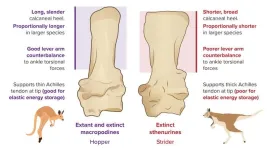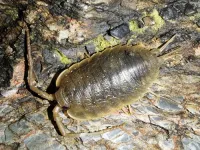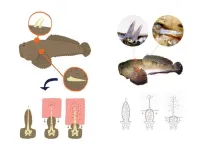(Press-News.org) The Bhopal gas explosion in 1984—one of India’s worst industrial disasters—may have heightened the risk of disability and cancer in later life among future generations, curbed their educational attainment, and prompted a fall in the proportion of male births the following year, suggests research in the open access journal BMJ Open.
The disaster is likely to have affected people across a substantially more extensive area than previous evidence suggested, say the researchers.
During the incident, toxic methyl isocyanate gas leaked from a pesticide plant near the city of Bhopal, spreading up to 7 km and exposing more than half a million people to the gas, killing 30,000 people. But research suggests that even those not directly exposed to the gas were affected.
Health consequences among the hundreds of thousands of survivors were wide ranging. But it’s not clear if the effects extended across generations, so a team of US researchers looked at the potential impact on children born to women survivors of Bhopal.
They drew on health and education data from the fourth wave of India’s National Family Health Survey (47,817 people born between 1960 and 1990 and living in Madhya Pradesh in 2015) and the 1999 Indian Socio-Economic Survey (13,369 people living in Madhya Pradesh) to estimate the health effects of the gas leak among 15-49 year olds living in Madhya Pradesh in 2015-16 as well as their children (1260) born between 1981 and 1985.
Analysis of the data showed there were long term, intergenerational effects. Men who were in the womb at the time and whose mothers lived close to Bhopal—within 100 km—were more likely (1 percentage point—over twice the baseline rate of 0.04%) to have a disability that affected their employment 15 years later.
More than 30 years later, men who had never moved also had a 27-fold higher risk of cancer and 2 fewer years of education than adults born before or after the disaster and who lived further away.
The sex ratio of births in 1985 also changed among children born up to 100 km away from the incident, suggesting that the effects of the disaster may have been more widespread than previously thought.
Among women living within 100 km of Bhopal the proportion of male births fell from 64% between 1981 and 1984 to 60% in 1985. But there was no difference in the sex ratio among women who lived more than 100 km away during the same period.
This finding is consistent with male fetuses being more affected by external stressors, say the researchers.
They acknowledge certain limitations to their findings, including the inability to assess the exact range of exposures to the toxic gas or the potential impact of migration and deaths attributable to the explosion, all of which may have affected their estimates.
Nevertheless, they conclude: “These results indicate social costs stemming from the Bhopal gas disaster that extend far beyond the mortality and morbidity experienced in the immediate aftermath.
“Moreover, our results suggest that the Bhopal gas disaster affected people across a substantially more widespread area than has previously been demonstrated.”
They add: “The evidence presented in this paper starkly highlights the long-term, inter-generational health and human capital effects of the Bhopal gas disaster, and underscores the need for ongoing survivor support, as well as robust regulatory protection.”
END
Bhopal explosion may have heightened risk of disability and cancer among future generations
And it may have curbed educational attainment and prompted fall in proportion of male births Disaster likely affected people across a substantially more extensive area than previously thought
2023-06-14
ELSE PRESS RELEASES FROM THIS DATE:
NHS “flying blind” in attempt to tackle ethnic inequalities in care, warns expert
2023-06-14
The NHS will be “flying blind” in its attempts to meet its legal, and moral, obligation to eliminate ethnic inequalities in health and care until longstanding problems with the quality of ethnicity data are resolved, warns an expert in The BMJ today.
Inequalities in health and care between ethnic groups have been documented for decades, explains Sarah Scobie at the Nuffield Trust. But she argues that analysis by broad ethnic groups (white, Asian, black, and mixed) can mask substantial variation within them.
An accompanying infographic presents some of these disparities across a range ...
Timing of childhood adversity is associated with unique epigenetic patterns in adolescents
2023-06-14
BOSTON—Childhood adversity—circumstances that threaten to a child’s physical or psychological well-being--has long been associated with poorer physical and mental health throughout life, such as greater risks of developing cardiac disease, cancer, or depression. It remains unclear, however, when and how the effects of childhood adversity become biologically embedded to influence health outcomes in children, adolescents, and adults.
A team of researchers at Massachusetts General Hospital (MGH), a founding member of Mass General Brigham (MGB), previously showed that exposure to adversity between ages 3 to 5 has a ...
Lockdown children played on, study finds, despite being stuck at home
2023-06-14
Children displayed a resilient capacity to continue playing during peak COVID-19, a study has found, even though their options to do so became more limited while under stay-at-home orders.
The research, by academics at the University of Cambridge, interviewed children themselves about their playing habits during the pandemic. Without disputing the consensus that COVID-19 impeded children’s healthy development, it does suggest that they were able to adapt their play habits to their changed circumstances.
Children largely expressed ...
Skipping evolution: some kangaroos didn’t hop, scientists explain
2023-06-14
Extinct kangaroos used alternative methods to their famous hop according to comprehensive analysis from University of Bristol and the University of Uppsala scientists.
Although hopping is regarded as a pinnacle of kangaroo evolution, the researchers highlight that other kinds of large kangaroos, in the not too distant past, likely moved in different ways such as striding on two legs or traversing on all fours.
In the review, published in Alcheringa: An Australasian Journal of Palaeontology, the team shows that there are other ways to be an evolutionary ...
Light pollution confuses coastal woodlouse
2023-06-14
Artificial night-time light confuses a colour-changing coastal woodlouse, new research shows.
The sea slater is an inch-long woodlouse that lives around the high-tide line and is common in the UK and Europe.
Sea slaters forage at night and can change colour to blend in and conceal themselves from predators.
The new study, by the University of Exeter, tested the effects of a single-point light source (which casts clear shadows) and “diffuse” light (similar to “skyglow” found near towns and cities).
While the single light did not interfere with the sea slaters’ camouflage, diffuse light caused them to turn ...
Giving birth outside of working hours in England is safe, suggests study
2023-06-14
A new study suggests that between 2005 and 2014, for almost all births in England, being born outside of working hours did not carry a significantly higher risk of death to the baby from anoxia (lack of oxygen) or trauma, when compared to births during working hours.
The finding runs contrary to an assumed, wider ‘weekend effect,’ with previously reported research suggesting a significantly higher risk of death for births outside of working hours or at weekends.
The current study from City, University of London ...
Brighter nights risk extinguishing glow-worm twinkle
2023-06-14
The bright lights of big cities are wonders of the modern world; intended to help us work, stay safe and enjoy the world around us long after the sun has set. While artificial light has been great for increasing human productivity, some nocturnal animals, and even people, pay a price for this illumination. From increasing the amount of time that predators are active to disrupting migrations, light pollution affects many animals; but how do animals that use their own luminescence to lure food or attract mates fair against this new, brighter background? Female common glow-worms (Lampyris noctiluca) emit a green glow from their abdomen to ...
Meat processing plants: What factors are critical for survival?
2023-06-13
URBANA, Ill. — Meat processing plants in the U.S. have garnered considerable public attention in recent years, often focusing on production and labor issues. The COVID-19 pandemic underscored the vulnerability of large, concentrated plants, as major shutdowns led to reduced output and higher meat prices for consumers.
Policy makers have launched initiatives at the state and federal levels to increase meat processing capacity and industry resilience, often favoring small and medium-sized plants. But little research exists to determine what factors make plants more likely to succeed. A new study from the University of ...
CHOP researchers develop universal MHC molecules that can be produced rapidly at scale
2023-06-13
Philadelphia, June 13, 2023— Class I major histocompatibility complex (MHC-I) proteins play an essential role in the immune system of all jawed vertebrates. The MHC-I displays peptide fragments of proteins from within the cell on the cell surface, “presenting” them to the immune system, which is constantly scanning the body for foreign or toxic antigens. When foreign peptides are identified, they trigger a cascade that allows cytotoxic T cells to eliminate intruders. This process has been exploited in the development of both vaccines ...
Peptide from venomous fish toxin controls lung inflammation in mice
2023-06-13
A molecule found in the venomous toadfish Thalassophryne nattereri has proved capable of controlling lung inflammation and could be the basis for a more effective asthma drug. The research was supported by FAPESP and conducted by scientists at Butantan Institute in São Paulo, Brazil. An article describing the results is published in the journal Cells.
A welter of fish species live in freshwater, seawater and a mixture of the two, and some of them are venomous. They have spines or stingers connected to venom glands, which ...
LAST 30 PRESS RELEASES:
Autistic and non-autistic faces may “speak a different language” when expressing emotion
No clear evidence that cannabis-based medicines relieve chronic nerve pain
Pioneering second-order nonlinear vibrational nanoscopy for interfacial molecular systems beyond the diffraction limit
Bottleneck in hydrogen distribution jeopardises billions in clean energy
Lung cancer death rates among women in Europe are finally levelling off
Scientists trace microplastics in fertilizer from fields to the beach
The Lancet Obstetrics, Gynecology, & Women’s Health: Taking paracetamol during pregnancy does not increase risk of autism, ADHD or intellectual disabilities, confirms new gold-standard evidence review
Taking paracetamol during pregnancy does not increase risk of autism, ADHD or intellectual disabilities
Harm reduction vending machines in New York State expand access to overdose treatment and drug test strips, UB studies confirm
University of Phoenix releases white paper on Credit for Prior Learning as a catalyst for internal mobility and retention
Canada losing track of salmon health as climate and industrial threats mount
Molecular sieve-confined Pt-FeOx catalysts achieve highly efficient reversible hydrogen cycle of methylcyclohexane-toluene
Investment in farm productivity tools key to reducing greenhouse gas
New review highlights electrochemical pathways to recover uranium from wastewater and seawater
Hidden pollutants in shale gas development raise environmental concerns, new review finds
Discarded cigarette butts transformed into high performance energy storage materials
Researchers highlight role of alternative RNA splicing in schizophrenia
NTU Singapore scientists find new way to disarm antibiotic-resistant bacteria and restore healing in chronic wounds
Research suggests nationwide racial bias in media reporting on gun violence
Revealing the cell’s nanocourier at work
Health impacts of nursing home staffing
Public views about opioid overdose and people with opioid use disorder
Age-related changes in sperm DNA may play a role in autism risk
Ambitious model fails to explain near-death experiences, experts say
Multifaceted effects of inward foreign direct investment on new venture creation
Exploring mutations that spontaneously switch on a key brain cell receptor
Two-step genome editing enables the creation of full-length humanized mouse models
Pusan National University researchers develop light-activated tissue adhesive patch for rapid, watertight neurosurgical sealing
Study finds so-called super agers tend to have at least two key genetic advantages
Brain stimulation device cleared for ADHD in the US is overall safe but ineffective
[Press-News.org] Bhopal explosion may have heightened risk of disability and cancer among future generationsAnd it may have curbed educational attainment and prompted fall in proportion of male births Disaster likely affected people across a substantially more extensive area than previously thought




